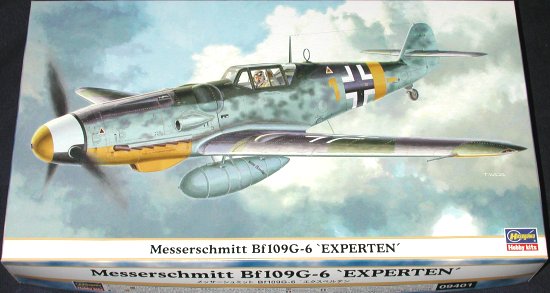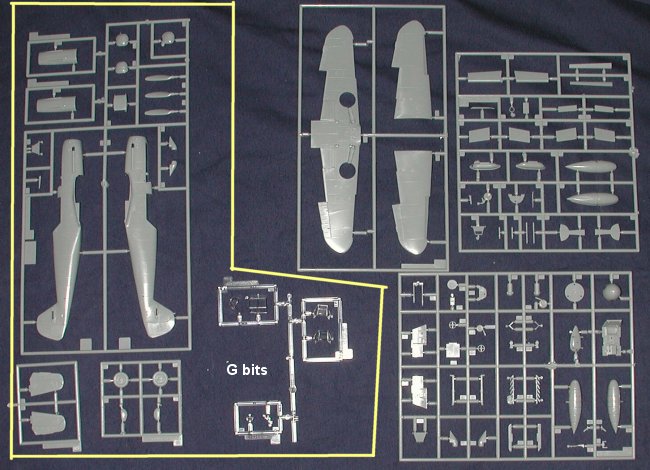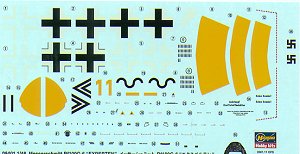
|
KIT: |
Hasegawa 1/48 Bf-109G-6 "Experten" |
|
KIT # |
09401 |
|
PRICE: |
$$25.95 |
|
DECALS: |
3 aircraft |
|
REVIEWER: |
|
|
NOTES: |

|
HISTORY |
Rather than concentrate on the history of the 109 (which many readers probably have memorized by now), I'll just say a few words about 1/48 Bf-109G kits. Hard though it is to believe, there were decades when modelers had NO 1/48 109G !!
It is true. We had several 109Es (Aurora and Monogram), and later an F (Airfix), but the G models and later were sadly missing from the shelves. 1/72 didn't have it too bad as there was a selection of various 109s and the full family of them when Heller came on board with its group in the 1970s.
However, 1/48 modelers had to suffer in silence until Otaki produced a 109G-6 sometime in the early 1970s. It was a pretty good representation of the 109G and modelers were happy to at least have something. As often is the case with these early models, it had some shape problems. About the same time, Fujimi produced a 'multi-purpose' 109 kit that was allegedly able to do all the versions from G-2 to K-4. Well, sort of.
In reality, it also cut corners as there is no way to really do multiple versions in a single kit. As we know now, if nothing else, there needs to be a new cowl for the later versions. However, it did offer a tall wooden tail as an option as well as a bunch of spare bits. We were happy.
Around 1978 or so, Revell AG released their 109G-10. This was the first really accurate 109 yet done and a later version as well. It is not a bad kit at all, and one that holds up well even today. It must do well for R-M as it has been pretty well available under one name or another since it came out. Even better, it could be built as an honest, to goodness K model with a bit of scratch building. Basically that meant outer gear doors and a taller tail. We didn't worry about such things as the different rudders and such as anal had not yet reached the heights that it has today!
Moving ahead to the mid/late 1980s. Fujimi comes on line with a series of very accurate 109s. Finally we could do all sorts of different variants right from the box. The major versions done were the G-6, G-14, G-14/AS, G-10 and K-4. No need to scratch build parts and an oodle of spares with each kit. Problem was that it was imported by MRC, who has always tacked on a very high surcharge to anything it imports, so these kits were at least $30 and eventually rose to $40 each. Many of them languished on the shelves unsold as modelers of the time couldn't justify that kind of price for a 1/48 109. Those of us who did buy them, did so when they were deeply discounted.
Just a few years after that, Hasegawa finally realized that Luftwaffe kits were a cash cow and has been milking it ever since. They have produced a staggering number of kits of the 109, starting with the F. Typical of the 'multi-use' nature of model kits nowadays, there are many common sprues for several of these kits. All the 109s have exactly the same wing, landing gear and interior sprues (C,D and F). From there, the other bits like wheels, fuselage, canopy, tail planes and such are added depending on the version being kitted. I'd be remiss to not mention the Hobbycraft kits. They are not quite up to the same standards, but then they are about half the cost. Hobbycraft does variants from G-2 to K and they look very good when done.
If you check Tony Hodun's magnificent work on cataloguing the Hasegawa kits, you can see what has been done. Is Hasegawa finished with 109s? I seriously doubt it. These kits are excellent sellers and the company has realized that there is a market for the 109 in 1/32 as well.
|
THE KIT |

This particular boxing of the G-6 kit is basically a decal change from the standard G-6 model. All of the G-6s are the earlier versions with the multi-framed canopy. You have to scribe in the extra panel line on the F wings and remove the outer sections from the circular wheel well on the lower wing to square it off. A few fuel filler points also need filled in and the trim tabs on the elevators need trimmed down.
You have options in regards to the upper cowl, windscreen, and the left cannon bulge depending on the plane you are doing. There are also different antennas to use and one of the variants requires the under wing 20mm cannon pods.
 Decals are provided for the aircraft of Helmut Lipfert of 6./JG 52 in December
1943, Anton Hackl of III./JG 11 in February 1944, and Gunther Rall of III./JG 52
in March 1944. All of the aircraft are in RLM 74/75/76 with various parts of the
airframe (lower cowlings or lower wing tips or rudders or fuselage bands) in
wither white or yellow. The fuselage bands and lower wing tips areas are
provided as decals, but it would be much better to paint these in order to match
any other areas similarly colored so the colors match.
Decals are provided for the aircraft of Helmut Lipfert of 6./JG 52 in December
1943, Anton Hackl of III./JG 11 in February 1944, and Gunther Rall of III./JG 52
in March 1944. All of the aircraft are in RLM 74/75/76 with various parts of the
airframe (lower cowlings or lower wing tips or rudders or fuselage bands) in
wither white or yellow. The fuselage bands and lower wing tips areas are
provided as decals, but it would be much better to paint these in order to match
any other areas similarly colored so the colors match.
|
CONCLUSIONS |
Unless you are a brand new to gluing, this is a kit that can be built by just about anyone who can follow instructions. It obviously is the best that there is in the minds of a lot of people as the contest tables are full of them. If you like 109s and haven't built one of these Hasegawa kits, you will.
If you would like your product reviewed fairly and quickly by a site that has well over 150,000 visitors a month, please contact me or see other details in the Note to Contributors.